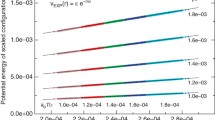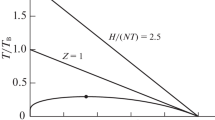Summary
The theory which has been discussed in this and preceding papers regards a liquid as being composed of a number of force centres or molecules each vibrating within an associated spherical space kept free from other molecules by the thermal motion of the occupying molecule. The transitional motion of the molecules through the liquid is assumed to be small compared with the vibratory motion. Each molecule attracts and repels the others with forces varying as inverse powers of the distance. The diameter of a spherical space is calculated, assuming that these spaces are closely packed, so that it is taken to vary with temperature. In the calculation of properties, such as L i andγ, it can be assumed that each molecule is on an average at the centre of its spherical space, and there need only be considered the attractive force since the repulsive force comes into play at distances much smaller than the diameter.
Similar content being viewed by others
|
Cf. Tyrer,Z. Phys. Chem., 1914,87, 178.
Gruneisen,Ann. d. Phys., 1912,39, 298.
Author information
Authors and Affiliations
Rights and permissions
About this article
Cite this article
Wheeler, T.S. On the theory of liquids—III. Proc. Indian Acad. Sci. (Math. Sci.) 1, 795–814 (1935). https://doi.org/10.1007/BF03035636
Received:
Issue Date:
DOI: https://doi.org/10.1007/BF03035636




